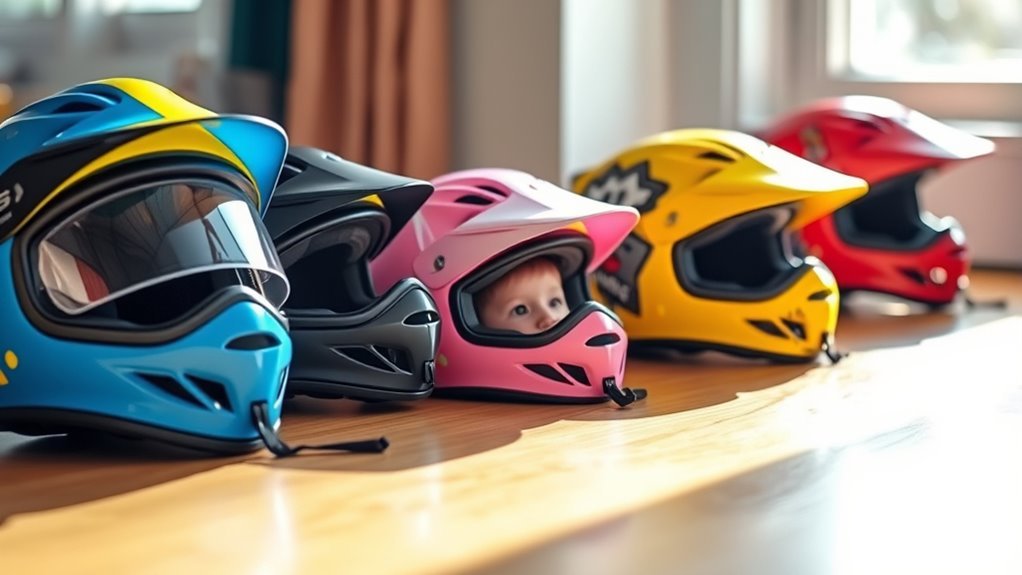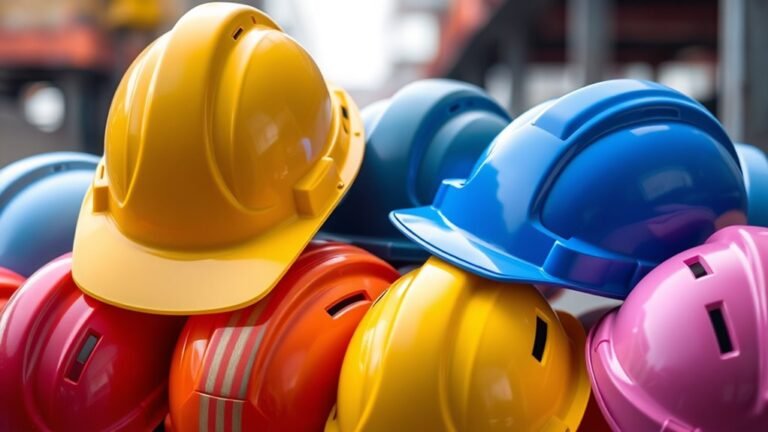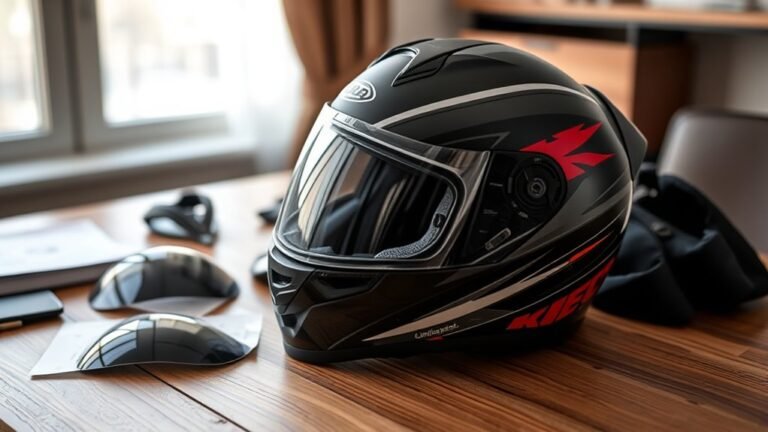Child-Size Motorcycle Helmets – Safety First
When it comes to child-size motorcycle helmets, proper fit is vital for your child’s safety. A helmet that’s too loose can shift during an accident, while one that’s too tight can cause discomfort. Always look for helmets with safety certifications, like DOT or Snell. Choose between full-face and open-face designs based on protection and comfort needs. Invest in quality helmets to prevent serious injuries and guarantee a safe ride for your child. Learn more about selecting the right helmet.
Understanding the Importance of Proper Helmet Fit
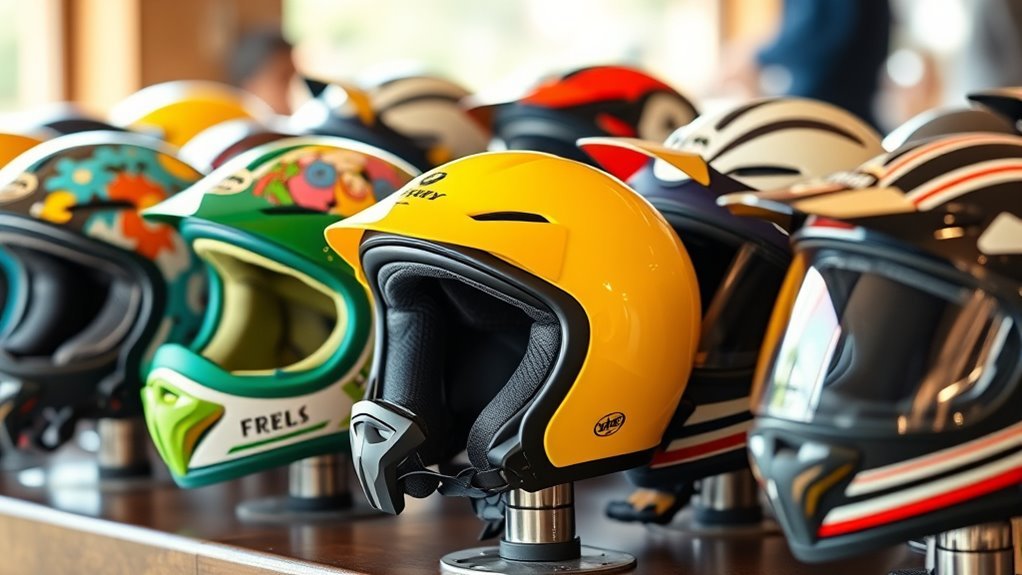
When it comes to safety, ensuring a proper helmet fit is essential, especially for children. A well-fitted helmet not only enhances helmet comfort but also maximizes child safety while riding. If the helmet’s too loose, it can shift during an accident, reducing its protective capabilities. Conversely, a helmet that’s too tight can cause discomfort, leading kids to remove it altogether. Always measure your child’s head to find the right size and adjust the straps accordingly for a snug fit. Remember, a helmet should sit level on their head, covering the forehead without obstructing vision. Prioritizing proper helmet fit allows your child to enjoy the freedom of riding while minimizing risk, making every adventure safer and more enjoyable.
Key Features of Child-Size Motorcycle Helmets
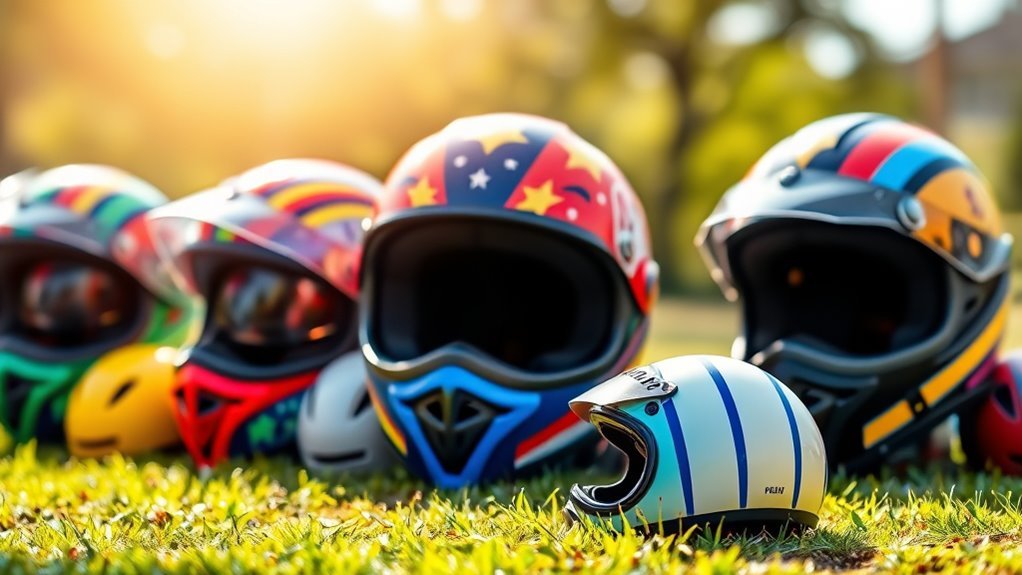
When choosing a child-size motorcycle helmet, you need to take into account a few key features to guarantee safety. Proper fit and sizing are essential, as well as compliance with safety standards to protect your child effectively. Additionally, lightweight and comfortable designs will encourage your child to wear the helmet consistently during rides.
Proper Fit and Sizing
Ensuring a proper fit and sizing for child-size motorcycle helmets is essential for safety and comfort, as an ill-fitting helmet can greatly reduce its effectiveness in protecting your child. Start by measuring your child’s head circumference and consult sizing chart guidelines to find the right size. Remember, a snug fit is vital; the helmet shouldn’t move around when your child shakes their head. Utilize helmet adjustment techniques, like adjusting the chin strap and padding, to fine-tune the fit. Make sure there’s no excessive pressure on their forehead, and check that the helmet sits level on their head. A well-fitted helmet enhances their riding experience while providing the freedom to enjoy the ride safely.
Safety Standards Compliance
While finding the right fit for a child-size motorcycle helmet is essential, it’s equally important to assure that the helmet complies with safety standards. Adhering to safety regulations assures your child’s protection during rides. Look for helmets that have passed rigorous helmet testing, confirming their ability to absorb impact and reduce head injuries.
| Standard | Description | Certification |
|---|---|---|
| DOT | U.S. Department of Transportation | Yes |
| ECE | Economic Commission for Europe | Yes |
| Snell | Independent testing organization | Yes |
| CPSC | Consumer Product Safety Commission | Yes |
| ASTM | American Society for Testing & Materials | Yes |
Lightweight and Comfortable Design
Choosing a lightweight and comfortable motorcycle helmet for your child is essential, as it can greatly enhance their riding experience. A well-fitted helmet not only provides safety but also encourages them to wear it consistently. Here are three key features to ponder:
- Ergonomic Design: Helmets with an ergonomic design guarantee a snug fit, reducing strain on your child’s neck during rides.
- Ventilation: Adequate airflow keeps the helmet cool and comfortable, making longer rides more enjoyable.
- Stylish Options: Kids love to express their individuality; stylish helmet designs can make wearing safety gear more appealing.
Types of Helmets: Full-Face vs. Open-Face
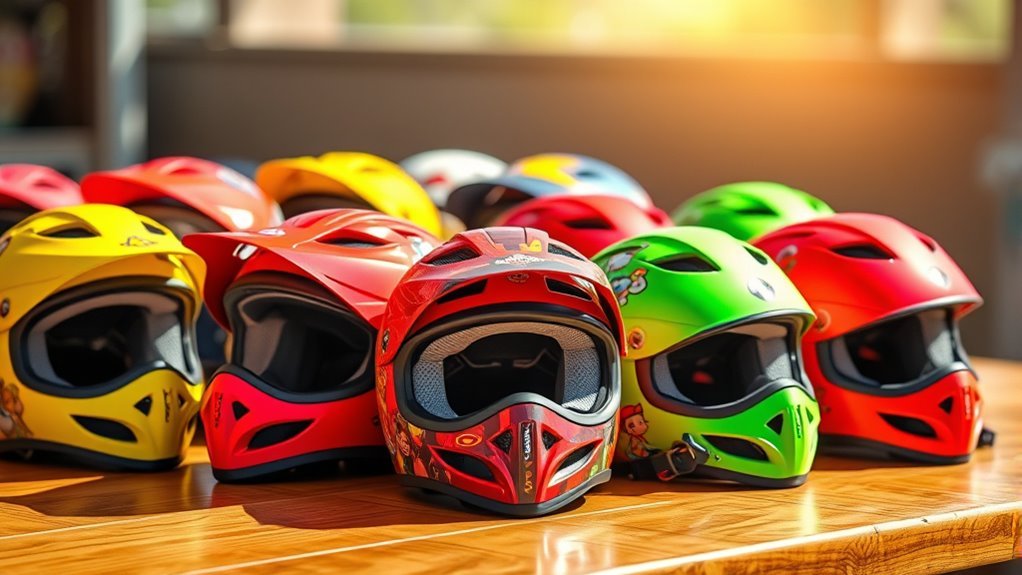
When choosing a helmet for your child, it’s vital to understand the differences between full-face and open-face options. A full-face helmet offers maximum protection, covering the entire head and face, which can be critical in an accident. On the other hand, open-face helmets provide greater visibility and comfort but may leave some areas exposed, so weigh the pros and cons carefully.
Full-Face Helmet Benefits
Although many riders appreciate the freedom of open-face helmets, full-face helmets offer significant advantages that enhance safety and protection. When you choose a full-face helmet, you’re investing in essential safety features that shield your head and face from impacts and elements. Here are three full face advantages to take into account:
- Enhanced Protection: Covers your entire head, reducing the risk of injury in accidents.
- Wind and Noise Reduction: Offers a quieter ride by minimizing wind noise, allowing you to focus on the road.
- Better Visibility: Many full-face helmets come with a visor that protects against glare and debris, improving your overall riding experience.
Choosing a full-face helmet means prioritizing your safety while still enjoying the freedom of the open road.
Open-Face Helmet Advantages
While full-face helmets provide extensive protection, open-face helmets have their own set of advantages that appeal to many riders. One of the primary open face benefits is the enhanced sense of freedom and visibility. You’ll enjoy an unobstructed view of your surroundings, which can make your ride more enjoyable. Additionally, the ventilation advantages in open-face helmets are significant; they allow for better airflow, keeping you cool during warm rides. This is especially important on hot days when comfort can impact your focus and safety. However, it’s crucial to remember that while these helmets offer more freedom, they may not provide the same level of protection as full-face options. Always weigh the benefits carefully before choosing the right helmet for your needs.
Safety Standards and Certifications for Helmets
Choosing the right motorcycle helmet for your child is essential, as safety standards and certifications play a significant role in guaranteeing their protection. You should look for helmets that have undergone rigorous helmet testing and have been approved by reputable certification agencies. Here are three key points to take into account:
- DOT (Department of Transportation): Helmets that meet DOT standards have passed essential safety tests, confirming they can withstand impact.
- Snell: This independent organization offers additional testing, often exceeding DOT requirements, providing extra assurance of quality.
- ECE (Economic Commission for Europe): European standards are known for their stringent testing procedures, making ECE-certified helmets a reliable choice.
Keeping these certifications in mind helps guarantee your child’s freedom to ride safely.
How to Measure Your Child’s Head for a Helmet
To guarantee your child’s helmet fits properly and provides maximum protection, it’s essential to measure their head accurately. Start by using a soft measuring tape, which is one of the best measuring tools for this task. Wrap it around the widest part of your child’s head, just above the eyebrows and ears, ensuring it’s snug but not too tight. This head measurement technique will give you the circumference in inches or centimeters. If you don’t have a measuring tape, you can also use a piece of string and then measure that against a ruler. Once you have the correct measurement, consult helmet sizing charts to find the right fit. A proper fit is vital for safety and comfort during rides.
Tips for Choosing the Right Helmet for Your Child
Once you’ve measured your child’s head and found the right size, the next step is selecting a helmet that offers both safety and comfort. When helmet buying, keep these key tips in mind:
After measuring your child’s head, focus on finding a helmet that ensures both safety and comfort.
- Check for Safety Features: Look for helmets that meet safety standards, like DOT or Snell certifications. These guarantee your child’s helmet provides adequate protection.
- Fit and Comfort: Ascertain the helmet fits snugly without pinching. It shouldn’t move around when your child shakes their head.
- Ventilation: Choose a helmet with good airflow to keep your child cool during rides, making the experience more enjoyable.
Prioritize safety features while considering your child’s preferences; it’s vital for a carefree ride!
The Role of Helmets in Preventing Injuries
While many parents might underestimate the importance of a helmet, it plays an essential role in preventing serious injuries during motorcycle rides. Research shows that helmets greatly reduce the risk of head injuries. In fact, injury statistics reveal that wearing a helmet can decrease the likelihood of a fatal motorcycle accident by nearly 37%. The helmet’s design absorbs helmet impact, protecting your child’s head from severe trauma. Without proper headgear, even minor falls can lead to life-altering consequences. It’s vital to prioritize safety and guarantee your child wears a certified helmet every time they ride. Embracing the freedom of the open road doesn’t mean ignoring the risks; investing in a quality helmet is a responsible step toward safeguarding your child’s safety.
Encouraging Safe Riding Habits in Young Riders
Wearing a helmet is just the first step in ensuring your child’s safety while riding. To foster safe riding habits, you need to be actively involved. Here are three essential practices:
- Invest in Riding Education: Enroll your child in a motorcycle safety course tailored for young riders. Knowledge is power, and education fosters confidence.
- Set Rules and Boundaries: Establish clear riding rules, such as no riding after dark and sticking to safe paths. Consistent guidelines help your child understand the importance of safety.
- Lead by Example: Show your child how to prioritize safety by always wearing your helmet and following traffic regulations. Your actions set a standard for them to follow.
With your involvement, you can help instill lifelong safe riding habits in your young rider.
Frequently Asked Questions
At What Age Should My Child Start Wearing a Motorcycle Helmet?
You should start having your child wear a motorcycle helmet as soon as they begin riding or even as a passenger. Motorcycle safety is paramount, and a properly fitted helmet can greatly reduce the risk of injury. Make sure the helmet fits snugly, with no wiggle room, and meets safety standards. Encourage good habits early on, as it’s essential for their safety and can foster a lifelong commitment to safe riding practices.
How Often Should I Replace My Child’s Motorcycle Helmet?
You should replace your child’s motorcycle helmet every three to five years or sooner if it’s been involved in a crash. Imagine the wind whipping through their hair, but remember, a helmet’s lifespan can diminish over time, even if it looks fine. Always guarantee it provides a proper fit, snug yet comfortable, to keep their adventurous spirit safe. Prioritize their protection, so they can enjoy the thrill of the ride worry-free.
Can My Child Wear a Helmet That’s Too Big?
No, your child shouldn’t wear a helmet that’s too big. A proper helmet fitting is essential for safety. If it’s loose, it won’t provide adequate protection during a fall or crash. Always follow size guidelines when choosing a helmet; it should fit snugly on their head without sliding around. Ensuring the right fit allows your child the freedom to enjoy their ride while keeping safety a priority.
Are There Specific Brands Known for Child-Size Motorcycle Helmets?
Yes, there are several brands known for child-size motorcycle helmets. When making brand comparisons, look for features like lightweight materials, adjustable straps, and proper ventilation. Brands like Bell, HJC, and Scorpion often receive high marks for safety and comfort. It’s essential to guarantee the helmet fits snugly without being too tight. Remember, a quality helmet can provide freedom on the road while keeping your child protected. Prioritize safety when choosing the right gear.
What Should I Do if My Child Dislikes Wearing a Helmet?
If your child dislikes wearing a helmet, it’s essential to address their comfort. First, make sure the helmet fits properly; a snug yet comfortable fit can make a big difference. You might consider adding fun incentives, like letting them decorate the helmet or choosing a cool design. Encourage them to wear it during playtime, fostering positive associations. Remember, while freedom is important, safety’s non-negotiable, so finding that balance is key!
